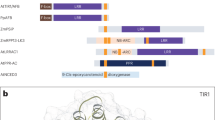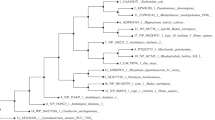Abstract
Previously, we characterized nucleotide sequences of two cDNAs encoding adenylate kinase from rice plants (Oryza sativa L.). Each cDNA (Adk-a or Adk-b) was cloned into the expression vector pET 11d-GST to produce GST-AK fusion proteins in Escherichia coli. Recombinant proteins were cleaved by thrombin, and GST-free adenylate kinase proteins were obtained. Enzyme activity profiles of different pH and inhibition effects to the enzyme by Ap5A (adenosine-5′-pentaphospho-5′-adenosine) indicates that both adenylate kinase proteins have similar biochemical characteristics. Among the nucleoside monophosphates (AMP, CMP, GMP and UMP) investigated, only AMP reacted with ATP. Furthermore, using the antiserum against the rice adenylate kinase proteins, the cellular location of adenylate kinase proteins was examined by immunomicroscopic analysis in combination with a subcellular fractionation method. The results indicated that adenylate kinase proteins were distributed largely in cytosol of rice cells.
Similar content being viewed by others
Abbreviations
- AK:
-
adenylate kinase
- IPTG:
-
isopropylthio-β-D-galactoside
- Ap5A:
-
adenosine-5′-pentaphospho-5′-adenosine
- PEP:
-
phosphoenol pyruvate
- GST:
-
glutathione S-transferase
- BSA:
-
bovine serum albumin
- FITC:
-
fluorescein isothiocyanate
References
Noda LH: Adenylate kinase. In Boyer PD (ed) The Enzymes, pp. 279–305. Academic Press, New York (1973).
Yan H, Dahnke T, Zhou B, Nakazawa A, Tsai MD: Mechanism of adenylate kinase. Critical evaluation of the X-ray model and assignment of the AMP site. Biochemistry 29: 10956–10964 (1990).
Yan H, Shi Z, Tsai MD: Mechanism of adenylate kinase. Structural and functional demonstration of arginine-138 as a key catalytic residue that cannot be replaced by lysine. Biochemistry 29: 6385–6392 (1990).
Schulz GE, Elzinga M, Marx F, Schirmer RH: Three-dimensional structure of adenylate kinase. Nature 250: 120–123 (1974).
Okajima T, Tanizawa K, Yoneya T, Fukui T: Role of leucine 66 in the asymmetric recognition of substrates in chicken muscle adenylate kinase. J Biol Chem 266: 11442–11447 (1991).
Heil A, Müller G, Noda L, Pinder T, Shirmer H, Shirmer I, VonZabern I: The amino acid sequence of porcine adenylate kinase from skeletal muscle. Eur J Biochem 103: 481–491 (1974).
Frank R, Trosin M, Tomasselli AG, Schulz GE, Schirmer RH: Mitochondrial adenylate kinase (AK2) from bovine heart. Eur J Biochem 141: 629–636 (1984).
Tomasselli AG, Noda LH: Mitochondrial ATP:AMP phosphotransferase from beef heart: purification and properties. Eur J Biochem 103: 481–491 (1980).
Tomasselli AG, Noda LH: Mitochondrial GTP-AMP phosphotransferase. Eur J Biochem 93: 263–270 (1979).
Tomasselli AG, Frank R, Schiltz E: The complete primary structure of GTP:AMP phosphotransferase from beef mitochondria. FEBS Lett 202: 303–308 (1979).
Walker EJ, Dow JW: Location and properties of two isozymes of cardiac adenylate kinase. Biochem J 203: 361–369 (1980).
Reinstain J, Vetter IR, Schlichting I, Rösch P, Wittinghofer A, Goody RS: Fluorescence and NMR investigation on the ligand binding properties of adenylate kinase. Biochemistry 29: 7440–7450 (1990).
Hampp R, Goller M, Ziegler H: Adenylate levels, energy charge, and phosphorylation potential during dark-light and light-dark transition in chloroplasts, mitochondria, and cytosol of mesophyll protoplasts from Avena sativa L. Plant Physiol 69: 448–455 (1982).
Kleczkowski LA, Randall DD: Maize leaf adenylate kinase. Purification and partial characterization. Plant Physiol 81: 1110–1114 (1986).
Kawai M, Kidou S, Kato A, Uchimiya H: Molecular characterization of cDNA encoding for adenylate kinase of rice (Oryza sativa L.). Plant J 2: 845–854 (1992).
Toriyama K, Hinata K: Cell suspension and protoplast culture in rice. Plant Sci 41: 179–183 (1985).
Maniatis T, Fritsch EF, Sambrook J: Molecular Cloning: A Laboratory Manual. Cold Spring Harbor Laboratory Press, Cold Spring Harbor, NY (1982).
Smith DB, Davern KM, Board PG, Tiu WU, Garcia EG, Mitchell GF: M26,000 antigen of Schistosoma japonicum recognized by resistant WEHI 129/J mice is a parasite glutathione S-transferase. Proc Natl Acad Sci USA 83: 8703–8707 (1986).
Sanger F, Nickelen S, Coulson AR: DNA sequencing with chain-terminating inhibitors. Proc Natl Acad Sci USA 74: 5463–5467 (1977).
Chiga M, Rogers AE, Plaut GWE: Nucleotide transphosphorylase from liver. J Biol Chem 236: 1800–1805 (1961).
Itakura T, Watanabe K, Shiokawa H, Kubo S: Purification and characterization of acidic adenylate kinase in porcine heart. Eur J Biochem 82: 431–437 (1978).
Bradford MM: A rapid and sensitive method for the quantitation of microgram quantities of protein utilizing the principle of protein-dye binding. Anal Biochem 72: 248–254 (1976).
Yonetani T: Studies on cytochrome oxidase. J Biol Chem 235: 3138–3143 (1960).
Karu AE, Moudrianakis EN: Fractionation and comparative studies of enzymes in aqueous extracts of spinach chloroplast. Arch Biochem Biophys 129: 655–671 (1969).
Schilts E, Burger S, Grafüller R, Deppert WR, Haehnel WH, Wagner E: Primary structure of maize chloroplast adenylate kinase. Eur J Biochem 222: 949–954 (1994).
Kleczkowski LA, Randall DD: Development of adenylate kinase activity upon greening of etiolated seedlings of C3 and C4 species. Photosynthetica 22: 112–115 (1987).
Author information
Authors and Affiliations
Rights and permissions
About this article
Cite this article
Kawai, M., Uchimiya, H. Biochemical properties of rice adenylate kinase and subcellular location in plant cells. Plant Mol Biol 27, 943–951 (1995). https://doi.org/10.1007/BF00037022
Received:
Accepted:
Issue Date:
DOI: https://doi.org/10.1007/BF00037022




